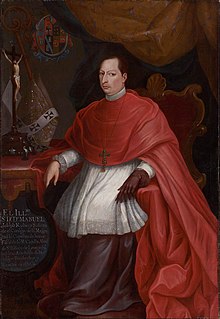Miguel Cabrera (painter)
Miguel Mateo Maldonado y Cabrera (1695–1768) was a Mestizo[1] painter born in Oaxaca but moved to Mexico City, the capital of Viceroyalty of New Spain.
His casta paintings, depicting interracial marriage among Amerindians, Spaniards and Africans, are considered among the genre's finest.
Cabrera was a favorite painter of Archbishop Manuel José Rubio y Salinas, whose portrait he twice painted, and of the Jesuits, which earned him many commissions.
"[8] The essential purpose of Maravilla Americana was to affirm the 1666 opinions of the witnesses who swore that the image of the Virgin was of a miraculous nature.
His involvement in the analysis of the Guadalupe image was part of his long term campaign to raise the status of painters from mere artisans to respected practitioners of the liberal arts.
It came at the same time that Mexican archbishop Manuel José Rubio y Salinas (1749-1765) sought the designation of the Virgin of Guadalupe as a universal patron.
[11] Most of the rest of his works are also religious in nature; as the official painter of the Archbishop of Mexico, Cabrera painted his and other portraits.



